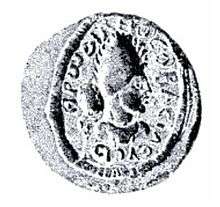Hairan I
| Hairan | |||||
|---|---|---|---|---|---|
| King of Kings of Palmyra | |||||
 Tessera depicting Hairan with his Greek name Herodian. | |||||
| King of Kings of Palmyra | |||||
| Reign | 263-267 | ||||
| Predecessor | Odaenathus | ||||
| Successor | Vaballathus | ||||
| Died | 267 | ||||
| |||||
| Father | Odaenathus | ||||
Septimius Herodianus or Hairan (died 267) was the son and co-king of Odaenathus of Palmyra. Through his father marriage to Zenobia, Hairan had a half brother with the same name Hairan II.[1]
Life
Hairan was born the son of Odaenathus and his first (unnamed) wife, and was chosen early in his father's career as a successor. In 251 he was mentioned in an inscription together with his father as a senators and Exarch of Palmyra. Hairan was crowned King of Kings by his father; the evidence for the crowning is a dedication found inscribed on a statue base from Palmyra which is undated.[2] However, the dedication was made by Septimius Worod as the duumviri of Palmyra, an office occupied by Worod between 263 and 264. Hence, the coronation took place c. 263.[3] The dedication imply that Hairan defeated a Persian army on the Orontes River.[4]
The inscription celebrating Hairan's coronation mention him with the name Herodianus.[5] It is possible that Hairan of the 251 inscription is not the same as Herodianus of the 263,[5] but this is contested by Udo Hartmann who conclude that the reason for the difference in the spelling is due to the language used in the inscription (Herodianus being the Greek version),[6] meaning that Odaenathus' eldest son and co-king is Hairan Herodianus.[7]
Hairan was probably murdered with his father under unclear circumstances in 267. Joannes Zonaras, called a cousin Maeonius as the murderer while the (especially with regard to the 3rd century) unreliable Historia Augusta indicate that Odaenathus' wife Zenobia was an instigator. Another possibility is that it was organized by Emperor Gallienus who feared Odaenathus was becoming too powerful.
References
- ↑ Richard Stoneman (1994). Palmyra and Its Empire: Zenobia's Revolt Against Rome. p. 114.
- ↑ Michael H. Dodgeon, Samuel N. C. Lieu (2002). The Roman Eastern Frontier and the Persian Wars AD 226-363: A Documentary History. p. 77.
- ↑ Udo Hartmann (2001). Das palmyrenische Teilreich (in German). p. 178.
- ↑ Michael H. Dodgeon, Samuel N. C. Lieu (2002). The Roman Eastern Frontier and the Persian Wars AD 226-363: A Documentary History. p. 370.
- 1 2 Pat Southern (2008). Empress Zenobia: Palmyra's Rebel Queen. p. 8.
- ↑ Alaric Watson (2004). Aurelian and the Third Century. p. 58.
- ↑ Pat Southern (2008). Empress Zenobia: Palmyra's Rebel Queen. p. 9.
- Thorsten Fleck: Das Sonderreich von Palmyra. Seine Geschichte im Spiegel der römischen Münzprägung. In: Geldgeschichtliche Nachrichten 199 (September 2000), pp 245–252.
- Udo Hartmann: Das palmyrenische Teilreich (Oriens et Occidens 2). Stuttgart 2001.
- Ted Kaizer: Odaenathus von Palmyra. In: Michael Sommer (Hg.): Politische Morde. Vom Altertum bis zur Gegenwart. Darmstadt 2005, pp 73–79.